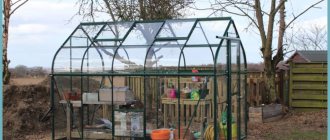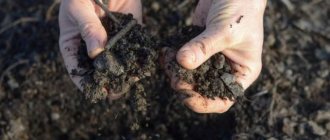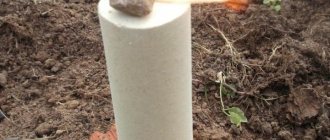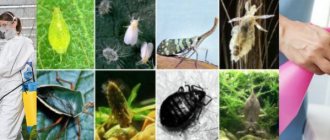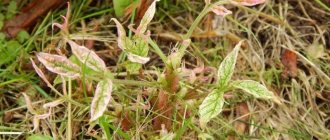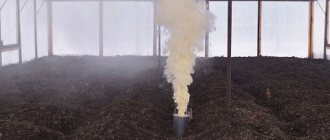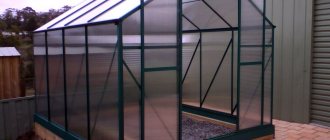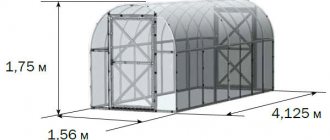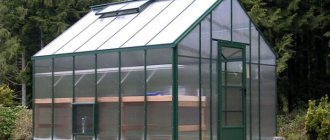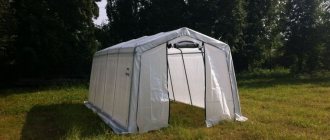In polycarbonate greenhouses, in most cases, a warm and humid environment is formed, which is a tasty morsel for the proliferation of various pests and microorganisms. To avoid an unpleasant situation, disinfection measures must be carried out against pests and diseases. The safest method is smoking with tobacco smoke. The use of tobacco sticks in polycarbonate greenhouses is an absolutely safe and reliable procedure. There will be no negative consequences to the coating and frame, since nicotine acts as an active ingredient. How tobacco is used in gardening will be discussed in our article.
Why is a tobacco shank preferable for a polycarbonate greenhouse?
The noticeable advantages of using tobacco shanks are:
- Easy to use.
- It fights various insects and diseases without any harm to the crops planted in the greenhouse.
- Tobacco smoke has a repellent effect against rodents and bees.
- Smoke penetrates absolutely into all places, even those hard to reach by humans.
- The carbon dioxide released is an excellent natural preservative that has a good effect on plant photosynthesis. The ripening time of the fruit accelerates, the foliage becomes juicy, thick and fleshy. There are no dangerous chemicals in the composition. Nicotine has a detrimental effect only against parasites.
- Using fumigation, you can treat large beds.
Winter ventilation
Despite the fact that green plants can synthesize oxygen themselves, the greenhouse must be ventilated even in winter.
This will provide protection from microbes, dry the air and limit the occurrence of unpleasant odors in the greenhouse.
For winter ventilation, it is best to use automatic ventilation systems. Mechanical systems are also acceptable.
Greenhouses that are used only during the warm season are recommended to be opened for the winter, providing cold and constant ventilation.
In what cases is a tobacco smoke bomb used?
If you notice that your crops that you are growing in a greenhouse have begun to grow and develop poorly, and also that the leaves are beginning to be affected by various diseases and pests, then this is a clear signal that you need to carry out tobacco treatment. Polycarbonate greenhouses especially need such treatment, since it is in them that the air humidity can be very high, which is a reason for the proliferation of pests and diseases. Here are the insects that tobacco sticks are good to use against:
- Aphid.
- Medyanitsa.
- Spider mite.
- Ground fleas.
- Butterfly
- Whitefly.
- Thrips.
- Late blight.
It is also possible to use tobacco checkers as a preventive measure:
- for routine disinfection of the greenhouse,
- to stimulate the growth of vegetable crops,
- in order to increase the safety of fruits.
The nicotine contained in drafts does not cause any harm to plants at all. Certain crops (potatoes, eggplant, peppers and tomatoes) contain small amounts of nicotine. Tobacco smoke has a short shelf life. Insect poisoning occurs only at the time of the procedure. It is for this reason that fumigation must be carried out more than once.
Prevention measures
The greenhouse is treated once a season or as needed, but the rest of the time preventive measures should be taken to prevent the development of late blight.
The following preventive measures must be taken:
- Monitor humidity. The air should not be over-humidified, because all microbes divide more actively in a humid and warm environment.
- Monitor the temperature.
- Initially select those varieties that are more resistant to the disease than others.
Types of tobacco checkers
In stores you can find several varieties of tobacco sticks, which we will discuss in more detail below. All these types of bombs have proven themselves to be safe for crops, unlike sulfur bombs.
In order for there to be any positive effect, you must strictly follow the instructions of the drug. If it is not there, then this product is uncertified.
Tobacco checker Hephaestus
The Hephaestus tobacco bomb contains tobacco crumbs and an incendiary mixture. The packaging has a cylindrical shape, the weight of the package can be 160 or 250 g. Well suited for combating various types of pests: spider mites, aphids, copperheads. It has a stimulating effect on the growth and development of the plant.
If the drug is opened, it can quickly lose its properties. If you have any substance left, it is best to store it away from flammable objects. The storage room must be dry, the air temperature must be +20...+25 degrees. If, for example, the area of your greenhouse is about 25 square meters. m, then it will be enough for you to purchase 1 piece.
Tobacco checker Phytophthora
This type of tobacco stick has proven itself well against fungal diseases: powdery mildew, late blight, rust and other types of fungi. The composition of the tobacco checker includes: tobacco chips, an igniter, a combustion stabilizer, and a large amount of sodium bicarbonate, which has destructive properties in the fight against fungi.
The drug has a cylindrical shape, weighs about 220g. 1 package of the drug will be enough to treat a greenhouse with an area of up to 35 square meters. m. The procedure of fumigation with the drug can be repeated 2 days after the first treatment. If the packaging has been damaged, the drug has the property of self-destruction.
Tobacco checker Vulcan
This type of tobacco stick is well suited for the fight against late blight, as well as other pests of garden crops. It is very popular among summer residents. The drug has a cylindrical shape. The composition includes: tobacco dust, ignition mixture, cardboard membranes.
If you are going to use the drug to stimulate plant growth, then 1 pc. The drug will be enough to treat 50 square meters. m plot. If you are going to carry out treatment against pests, then for 30 square meters. m 1 pc. drug. Insects do not get used to the drug.
Description of the product and principle of its action
A smoke bomb visually represents a package weighing 300 grams. It is usually collected from 5-10 tablets, which are enough to treat a room with a volume of up to 20 cubic meters.
Smoke bombs are filled with various chemicals. The most common ones are:
- sulfur;
- permethrin;
- tobacco dust;
- hexachlorane;
- didecyldimethylammonium.
Most often, sulfur and tobacco bombs are produced, which will be discussed. In the first model, the active substance is sulfur, which belongs to the second hazard class and is toxic to people, birds and bees. It is prohibited to set it on fire in the basement under a residential building or under the floor.
The industry produces several types of such checkers, but their operating principle is the same. After igniting the fuse, the combustion process begins, during which the checker emits sulfur dioxide. It is lighter than air, and therefore completely fills the smallest cracks and crevices, having a detrimental effect on pathogenic microbes and insects.
This is interesting: smoke bombs are divided into universal (they get rid of mold and parasites) and specialized (against moles, rodents and insects).
How to properly use a tobacco shank in a greenhouse
Before processing with a tobacco stick, everything in the greenhouse must be thoroughly cleaned, namely:
- We are cleaning the top layer of soil, removing foliage and dead areas of plants.
- We are dismantling the racks.
- Remove all unnecessary items from the greenhouse: boxes, boxes, containers.
- The greenhouse covering needs to be cleaned with a soap solution. It is especially necessary to wash joints and seams. They may contain various microorganisms and pest larvae.
- Loosen the soil so that combustion products can more easily penetrate the soil. At the same time, various parasites and mold will also be destroyed.
- Seal the greenhouse, paying special attention to cracks, gaps, and joints.
- Walls and soil need light moisture. A humid environment is suitable for better smoldering. Arrange the brick stands evenly.
If you plan to use only 1 pc. drug, you can place it exactly in the center. To correctly calculate how many checkers you will need, you need to take into account its size and the purpose of their use.
When should you treat for late blight - in spring or autumn?
Late blight loves warm, moist environments. Therefore, when the temperature outside is above 20 °C during the day and cool at night, microorganisms begin to multiply intensively.
It is better to process in the spring with the onset of warmth, until the fruits are ripe. And it makes sense to disinfect the greenhouse in the fall, because the fungus can survive in the cold due to spores.
What time to choose
It is best to disinfect greenhouses in the spring and autumn. To improve the first treatment, it is best to repeat the fumigation procedure 4-5 days after the first treatment.
If you are going to plant vegetables in the spring, then the first treatment with tobacco is best done 3 weeks before planting.
Autumn processing can be carried out after you have harvested the crop. After the procedure is carried out, the room will need to be well ventilated and closed until the next season.
It is possible to use tobacco sticks during the period of active plant growth. There is no need to remove vegetable crops from the greenhouse; the smoke will not cause any harm to the plants. It is best to carry out the fumigation procedure in the evening, in cloudy or cool times, so that the vegetables cannot die from the stuffiness.
Disadvantages and pros
Like any fungicide, a smoke bomb has positive and negative sides. Disadvantages include:
- high degree of toxicity of the emitted smoke;
- the toxic substance is absorbed into vegetables and fruits;
- oxidation of metals was observed during use;
- fire hazard: the product may ignite flammable materials;
- water poisoning: if ground flows come close to the soil surface, the saber should not be used to treat the basement;
- poor penetration into soil and wood: fungal spores and pests, without prior preparation, remain in the thickness of the black soil, and mold remains in the boards;
- destruction of plants: burns remain on living crops after exposure.
Despite the long list of disadvantages, this product also has advantages. For example:
- efficiency;
- sufficient efficiency;
- ease of use;
- convenience;
- safety during ignition: before combustion begins, the wick pauses for 1 to 2 minutes.
Next, we’ll take a closer look at when it’s worth treating a greenhouse with a sulfur bomb.
How to properly light a smoke bomb in a greenhouse
Setting fire to a tobacco stick must be carried out on the street. You need to install it on a pedestal of bricks, light the wick and move back a little so that the flames cannot touch you and your clothes. After about 15-20 seconds it will go out and the desired fumigation process will begin. After this, it can be sent to the greenhouse.
Checkers must be placed around the perimeter of the room, do not forget to close the door tightly. The smoking process can continue for several hours. After completing the procedure, the room should be well ventilated and after a few days the fumigation procedure should be repeated.
Many say that the use of drugs has a detrimental effect on insects after 1 treatment, and after the 2nd procedure the larvae themselves begin to die. There is no effect of smoke on eggs.
Review of manufacturers
There are several types of smoke bombs available in specialized stores. The most popular among them are:
- “Pawn-S”, “Pawn-B” - have proven themselves well in polycarbonate greenhouses. The sulfur in them is not compressed, but poured. It operates on the principle of a pesticide aerosol, filling greenhouses not with smoke, but with microparticles of sulfur. With this method, the amount of sulfuric acid is much lower than the limit. It is advisable to have forced ventilation in the room being treated, and then leave it closed for at least 12 hours to allow the aerosol to settle. Price from 400 rub.
- "Climate" - represented by large tablets, collected 5-10 pieces in cylinders, and a wick. Both one tablet and the entire pyramid are set on fire. Disinfects greenhouses in 36 hours. The basement should be disinfected at least 5 days before planting the crop. The price of a package (10 tablets) is within 70 rubles.
- "FAS" - one of the most affordable sulfur bombs. It looks like a smoke grenade, and is also enclosed in a polycarbonate casing. Can be produced in the form of a triangle or a cylinder. Comes with a wick. It is extremely toxic and requires long-term ventilation at the end of the treatment process. It is prohibited to light in sheds where livestock will presumably be kept. Price from 90 rub.
In addition to smoke sulfur bombs, tobacco and permethrin bombs are also produced. They have a third hazard class. These devices are approved for use in the presence of animals, in general premises, are not toxic to living plants and are harmful to parasitic insects. Among them it is necessary to note:
- "Volcano" - consists of tobacco dust, but it is still not recommended to be nearby. Costs from 200 rubles;
- "Hephaestus" - has a tobacco component, so it can be used next to living plants (on average 250 rubles);
- "Whist" - fights various fungi and lasts for more than six months. Available at a price (from 50 rubles).
In general, treating a room using a sulfur bomb is not difficult. The main thing is to take precautions, strictly follow the instructions and do not smoke in the presence of animals and people. And regular use of the product will save you from mold in the corners of the basement and pests in greenhouses.
Compliance with safety measures
The use of tobacco cones is absolutely harmless both for people and plants, and for the polycarbonate greenhouse itself. But you still need to take certain precautions:
- If you are going to use several pieces of tobacco sticks, then you must wear safety glasses to protect the mucous membrane of your eyes.
- To protect exposed parts of your body, it is best to wear long sleeves.
- When you install the checker, you need to hold your breath for a while.
- The room must be airtight so that the smoke does not escape outside the greenhouse.
- You should not be inside the greenhouse during the fumigation procedure.
- After the burning ends, you cannot enter the greenhouse for several hours. Dissipation of carbon dioxide must occur.
Reviews
Olga Polyakova, 40 years old, Alexandrov We used a Hephaestus smoke bomb, we did everything according to the instructions, tobacco smoke killed all the pests, and we harvested a large crop.
Svetlana Goryunova, 51 years old, Vladimir I tried fumigation with different means, but most of all I appreciated “Late blight”. The cucumber leaves were affected by some kind of disease, after several fumigation procedures they began to turn green and the plant began to recover. The fruits were not damaged by smoke. Now every year I carry out disinfection with “Late blight” - in spring and autumn.
Pavel Rybin, 59 years old, Suzdal I always smoke Hephaestus. In my opinion, this is the best remedy for pests and late blight. The main thing is not to enter the greenhouse until the smoke has completely cleared. I don’t use sulfur bombs, because I consider them harmful to plants and human health.
We carry out a set of works after processing the greenhouse using a tobacco checker
If you use the tobacco sticks that we previously reviewed, then there is no need to carry out any specific work. You just need to ventilate the greenhouse well so that all the smoke and smell disappear completely. Then you can go about your normal business there. If you need to enter it before the burning ends, do not forget about the protective mask.
Tobacco can be used throughout the season. It does not contain chemicals. The checker is easy to use. It is good at combating many pests and diseases that can negatively affect the development of vegetable crops. It is important to remember that when using tobacco pellets you must follow safety precautions and follow all operating instructions
Land like fluff is the key to a decent harvest
The soil for planting in the greenhouse is prepared in the fall - all vegetation, garter devices and tools are removed, the soil is dug up, and then left to rest for the winter.
All these events can be carried out in the spring, if there was no time in the fall.
Preparing the soil in a greenhouse
For those who have the opportunity to get to their dacha at any time of the year, it would be a good idea to replenish the soil in the greenhouse with snow from the site. This will fill it with natural moisture and beneficial microelements.
When the land is ready for cultivation, it should be dug up (if the land was cultivated in the fall, the process will be easy and quick) and fed with organic fertilizers - peat, humus. Add ash. We level the ground, make it free of lumps, remove the roots and sprouts of revived weeds.
How to disinfect the soil before planting seedlings in a greenhouse
Before planting seedlings, the soil must be cultivated. This may be thermal, chemical or biological treatment. Agronomists advise changing the method of cultivating the soil in the greenhouse every year so that parasites do not develop immunity.
Gardeners share how to disinfect the soil before planting:
Hom has long been actively used by gardeners both for the preventive protection of plantings and for the treatment of already diseased plants. Quickly eliminates late blight, scab, rust, downy mildew, spotting, rot. The main active ingredient is copper.
Fitosporin is a biological preparation containing bacilli that, when they enter the ground, multiply, thereby clearing the soil of pests.
Copper sulfate is the oldest and most common chemical means of protecting plants from infections. Summer residents often prefer to use it instead of more modern drugs. This is an excellent antiseptic and fungicide.
Copper sulfate is highly acidic. To neutralize acid, use vitriol in combination with lime to neutralize acidity and not harm the soil.
Steaming . The earth is poured with boiling water - a bucket per 1 sq.m of land, and then covered with thick polyethylene and left for a couple of days.
In addition to the listed means and preparations, there are a huge variety to combat parasites that multiply in a greenhouse; the article lists only the most common ones among summer residents. For adherents of only folk remedies, infusions of mustard, pine needles and tobacco are suitable.
Remember! If the rules of use and recommendations for use are not followed, chemical and biological substances can harm the soil and destroy young seedlings.

